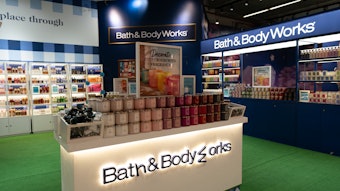Walk into any beauty aisle. Look on the beauty shelves of pharmacies and department stores. Everywhere are beautifully designed products, new technologies, new colors, new brand identities, new packaging and new ways to compete.
As consumers, people constantly analyze what they see, but when a product grabs their attention, most consumers are entirely predictable. They open the cap, squeeze the bottle, or spray the scent blotter, and smell. It’s a moment of truth that inspires most to make a buying decision right there—or frankly, move on.
Nobody respects that magic moment more than beauty brand owners and product developers—and nobody shares their concern more than those who design and create fragrances. Fragrance designers often see consumers as judges with their placards ready, and they figuratively wait on their toes as consumers raise their cards—or dollars— in confirmation: “Ten! Ten! Ten!”
However, if you think a smell test is the only review factor at work in consumer decision-making today, think again. Before the cap is opened, the bottle squeezed or the scent sprayed, consumers have already made serious decisions about the product. In fact, just by looking at a product and its packaging, they have probably formed pretty well-developed ideas about how the product is going to smell. Consequently, aligning color and fragrance is one of the most important tools a brand can wield.
The Power of Color
The key to a consumer’s ability to analyze a brand’s product on a shelf, which also contains dozens of other items she could buy, is color—the same color that can be something art directors and graphic designers take for granted. But significantly, not all signals processed by the human eye go directly to the visual center of the brain.
According to the Pantone Color Institute, approximately 20% of all visual signals go to the tiny part of the brain that produces the hormones that control homeostasis, our essential sense of balance and well-being as humans. That explains color’s power to influence how people feel about themselves, and colors consumers love actually make them feel better—just like fragrance, which connects to the same part of the brain.
To explore the connection between color, product design and fragrance, a perception study was conducted among female consumers in the Atlanta area by researchers at Arylessence. The findings revealed that not only are the senses of sight and smell closely linked, but specific colors actually shape olfactory expectations. If a consumer sees the color green, the study determined, that person starts to think “green,” and consequently, expects any aroma associated with said product to have a “green” scent. If a consumer sees yellow, she thinks “lemon” and expects a citrus scent. The same is true with colors across the spectrum. Even the intensity of colors is seen to influence consumer perceptions.
When asked to describe fragrances inspired by specific colors, consumers consistently use the same words and descriptors. People perceive very subtle differences between colors, see the same values in particular colors, and consistently describe the fragrances based on those colors. Light yellow is seen as “stimulating” and “uplifting.” Navy blue is consistently “masculine,” “stimulating” and even “soothing.” Deep purple? It’s widely considered “soothing” and “feminine.”
The consistency of these responses says the connection between color and fragrance is predictable. Meaning, if your brand is built on a definitive color platform, you can far more easily send consistent messages to consumers, consistently set expectations about your brand’s qualities and attributes, and be consistently perceived a particular way by consumers. And that’s a direct route to consumer acceptance.
Aligning Concept, Color and Fragrance
The message for beauty brand developers and marketers is a simple one. It’s all about alignment. Because the consumer expects consistency in product concept, color and fragrance, that consistency should be built into a brand upfront. The stronger the connection between concept, color and fragrance, the more likely the consumer will be to purchase the product.
From a planning perspective, these three components need to work together. Study each component and bring relevant information together in one place to create a comprehensive guide for your team, as well as your fragrance developer.
First, concept. What is the product, and what does it offer, functionally and emotionally? Who is the target consumer? How do you define her attitudes, beliefs and behaviors?
Next, move to color. What is the brand’s color identity? What will be the predominant colors of the product, packaging and promotional materials?
Finally, consider fragrance. What fragrance notes are indicated by the product category? How is the product used? How will this particular version of the product be positioned? What fragrance notes are evoked by the selected color? How should all these ideas come together?
Interestingly, perfumers often see color the same way consumers do and consistently use color as a stimulus for creative thinking. As trained professionals, perfumers organize fragrance palettes using colors to reflect the major scent families: citrus (yellow), florals (pinks, whites, and mauves), woods (greens), chypre (browns), orientals (reds and oranges) and so on. Additionally, new subfamilies such as ozones and watery influences are typically blue. Among the best perfumers, there is no learning curve for color.
It’s about what is natural and logical. Cues from nature are the most obvious—red for apples; herbal scents associated with green; and citrus in the form of lime, orange, tangerine and lemon. Also, many colors name both a color and an object: lilac and lavender are both colors and flowers, and both have a distinctive scent. Using mauves, purples and lilacs in a brand’s color profile demands the use of scents such as lilac and orris to fulfill consumer expectations.
Remember, too, the intensity of a fragrance correlates with the intensity of the colors. Pastels ask for lighter, softer, more esoteric fragrances. Subtle spa aromas require muted shades that are calming and tranquil, and a vibrant yellow is likely about a fresh, effervescent lemon or succulent pineapple scent.
It’s also important to think about the emotional cues of color, especially when there’s love, caring or aspiration in the product positioning. For example, what colors depict concepts such as “caress,” “embrace” or “kiss”? Building color dimensions into signature fragrances can help define a whole brand and its variants.
Making Color and Fragrance Happen
Because consumers expect color and fragrance to work together—and because color is already part of perfumery—product development teams should use the color-fragrance synergy to ignite a brand and its products.
Remember that everything works in harmony. Consumers evaluate the whole package, not just individual components. A clearly defined product concept with consistent design and fragrance themes gives consumers more to connect with and more to remember.
Color inspires everyone. Consumers like colors that make them feel better. Perfumers know a winning fragrance is the fastest way for a consumer to say yes to a product, and that the right color is a fast track to a winning fragrance.
Color and fragrance are category changers. Most products in a category look similar, and even often the same. A product must clearly belong in a category but also stand out. Perfumers and packaging designers working together can make that happen.
Be smart about trends. Consumer trends aren’t about one single data point or one moment in time. They are about what’s happening over time, and multiple data points actually make trends real. Look for trends that include color, and include color strategy in how you respond to trend inputs.
In the end, developing signature scents with the right color cues can create powerful brand recognition and, ultimately, very loyal brand fans.
Michelle Harper is the director of fragrance evaluation at Arylessence. Previously a fragrance chemist with Calvin Klein, in her work now she translates trends, consumer behaviors, marketing objectives, competitive dynamics and more to develop innovative fragrances. She also is a key contributor to the annual Arylessence TrendWatch report, which identifies deep consumer trends and applies them to fragrance.
Lori Miller Burns is the Arylessence director of marketing, helping the company’s clients evolve brands with fragrance. She brings insights from the marketplace into fragrance evaluation, applying consumer trends and behaviors to the development of fragrances. She also manages the annual Arylessence TrendWatch report. Miller Burns has previously worked as a brand, product and system marketer for brands such as Clinique, Aveda and The Body Shop.











